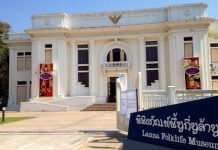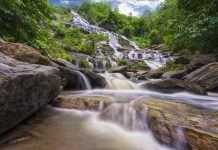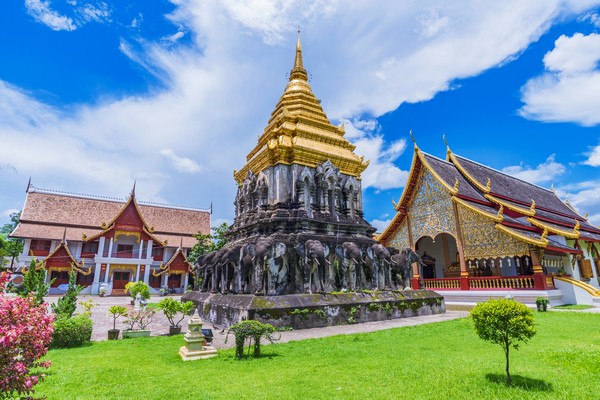
Wat Chiang Man, the oldest monastery of Chiang Mai
In the north of the ancient city of Chiang Mai is where the location of the very first royal monastery of this town. The holy place was created by Phrya Mangrai and later the king commanded to invite the Buddha images called “Phra Setangkamanee” or “Phra Kaew Khao” (the White Crystal Buddha) and the Buddha statue in the attitude of conquering Narakili elephant to house at the temple (created in the period of Queen Chamadevi).
Furthermore, the great pagoda at Wat Chiang Man which the Gautama Buddha’s relics (hair) said that to be enshrined inside is outstanding from other temples since it is a square-shaped pagoda with 16 stucco figures of elephant stand around the base. Besides, there are lots of religious objects and architectures within the compound that are worshiped by the people of Chiang Mai and outsiders.
History of the Ancient Temple “Wat Chiang Man”

Wat Chiang Man is another important monastery which exists in the city legend and the chronical of Yonok. According to the record, after Phya Ngam Muang, Phya Ruang, and Phya Mangrai completed the establishment of Chiang Mai city in 1296. The three kings bestowed to build the main pagoda over the space of the residence at Ban Chiang Man that Phya Mangrai made for temporary stay during the construction of the new city. The residence titled ” Wieng Lek” which means stability.
After that, King Mangrai relocated to the new royal court called “Wieng Kaew” which currently is “Chiang Mai Central Prison.” And the king graciously dedicated the villa ” Khum Wieng Lek” to the Buddhism to be the first royal monastery and named “Wat Chiang Man” which means “the stable city.”
The first royal monastery in Chiang Mai
So, it could say that Wat Chiang Man is the first royal monastery within the city wall of the historic city “Chiang Mai.” The temple was found in 1296 and then assumingly the grand pagoda tumbled down in the throne of King Tilokarat, the 10th king of the Mangrai House who reigned Lanna during 1442-1488, and the king ordered to rebuild it from the laterite in 1471.
Later, in 1551 Chiang Mai was ruled by Burma, and Wat Chiang Man was abandoned to be deserted. Until a king of Burma called “Chao Fa Mangtra” or “Somdet Phra Thammika Rachatirat” who has deep faith in Buddhism bestowed to construct pagoda, vihara, ubosot, Tripitaka Hall (the library to store the Buddhist scriptures), pulpit, defensive wall, and Khong Arch at Wat Chiang Man. And also appointed the Buddist monk called ” Phra Mahahinta Titjawangsa” as an abbot of the monastery. Then, in the reign of Phrya Kawila the ruler of Chiang Mail (1781-1815) did another proper renovation for the compound after the temple was desolated during the wartime to gain the independent from Burma since 1776.
Afterward, in the age of King Intavaroros (1897-1909), the Buddhism Thammayut Nikaya expanded to the Lanna Kingdom. King Intavaroros, therefore, invited the Thammayut monks to reside at Wat Chiang Man for the first time and transferred to Wat Hor Tham and Wat Chedi Luang respectively.
About the Monastery of Wat Chiang Man
Wat Chiang Man is literally the oldest temple in Chiang Mai town which has existed with this ancient city since the establishment in 1296. King Mangrai donated his royal court “Wieng Chiang Man” to settle the royal monastery and named “Wat Chiang Man.” Also, the king commanded to build the main pagoda “Chedi Chang Lom” at the area of his residence.
The compound consists of two viharas or the sermon hall which are;
The Main Vihara
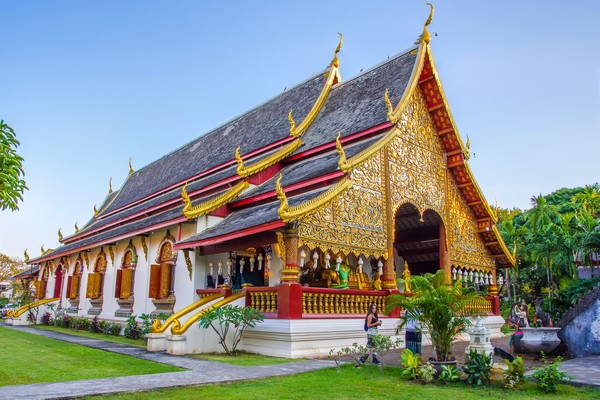
The hall built which just built in the present time is magnificent with the delicate mural painting in gold on the red background that decorated in between the windows. The art is the story of the establishment of the cities and temples by King Mangrai in both “Wieng Kum Kam” and “Chiang Mai.”
“Vihara Lek” The Little Vihara
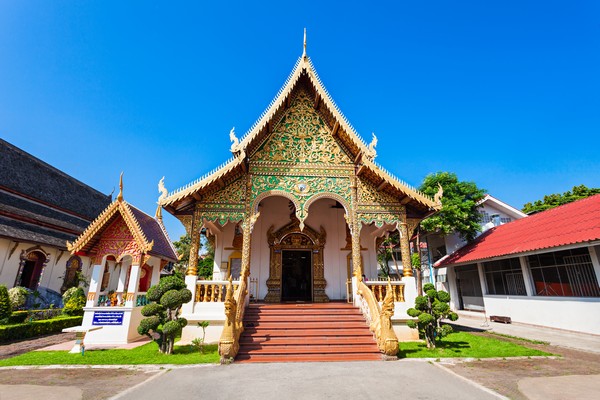
Little Vihara or in Thai “Vihara Lek” or so-called literally “Vihara Jaturamuk” (building with four gable ends) which is the house to enshrine one of the most significant Buddha images of Lanna is “Phra Sae Tangkamanee” or “Phra Kaew Khao.” Phra Kaew Khao is the symbolic Buddha image of Queen Chamadevi of Hariphunchai Kingdom and also being worshiped among Chiang Mai people. Further, there is another is “Phra Sila” the Buddha statue in the attitude of conquering Narakili elephant (the Walking Buddha with Ananda Thera, his disciple and an elephant called “Narakili”).
And Ubosot (the ordination hall) of Wat Chiang Man is another sacred thing towards Chiang Mai residents very much because there is a stone inscription of Wat Chiang Man at the entrance of the hall. The ancient finds recorded the story about the establishment of Chiang Mai and the background of the temple, including the preservation of the temple by the Lanna Royalty.
What to See at Wat Chiang Man
The Main Hall or Ubosot
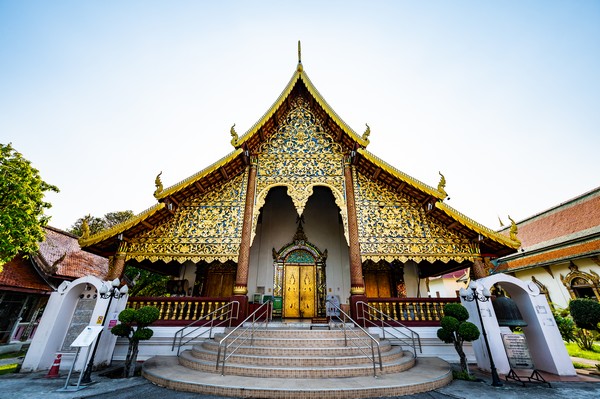
The ordination hall stands in the south of the temple next to Tripitaka Hall. The Lanna style architecture stored a stone inscription column 76 which recorded in 158. The ubosot was built at the same time as the construction of vihara and Tripitaka library. And also, it proclaimed to be the national historical site together with the grand pagoda, vihara, and Tripitaka Hall of the temple.
Chedi Chang Lom (The Elephant Pagoda)
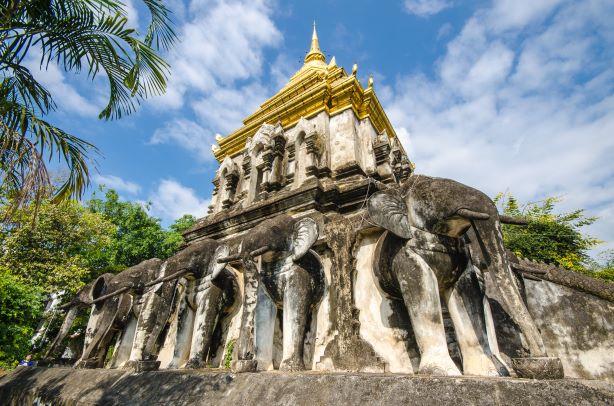
As most ancient temples in general, the pagoda is the main sacred and oldest structure of the complex. Chedi Chang Lom is the Lanna art with the figures of the elephant at the base. The pagoda is mixed of Lanna and Ceylonese style as the square-shaped and bell-shaped covered with Jangko gold (brass leaf, lacquered and gilded. It was created in 1297 when King Mangrai found Wat Chiang Man, and after that, the monastery had been maintained by the rulers of Chiang Mai from time to time. And the Department of Fine Arts registered the site as the national historical site in 1935.
Phra Kaew Khao
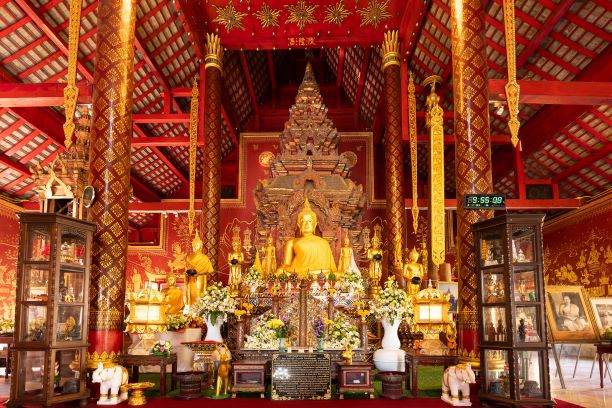
“Phra Kaew Khao” or officially called “Phra Setangkamanee” is esteemed by the Buddhist in the north as the consecrated Buddha image in which the magical power to protect one from harm and bless the prosperous life to the devotees.
Phra Sila or Phra Seela

A Buddha image in the attitude of conquering Narakili elephant made from black slate (or some records said laterite). The statue is art by Pala artist from India and craved based on the ancient belief of them. The image appeared in the free-form standing posture on the Lotus platform under the arch.
On The right hand of the Buddha reach over the head of bowing elephant, and the left hand raise up in the attitude of forgiveness or giving the sermon with Ananda Thera his disciple stands with the alms bowl on the left of the Buddha. Presently, the significant image located together with Phra Setangkamanee (Phra Kaew Khao) inside the main vihara.
A Stone Inscription of Wat Chiang Man
An ancient stone installed at the front of the ordination hall of the compound. The inscription mentioned to the name of the three kings namely King Mangrai, King Ngam Muang, and King Phra Ruang (King Ramkhamhaeng) that all of them collaborated to found the city of Chiang Mai.
Also, the background of Wat Chiang Man from the establishment to maintenances by the kings and royalty of the northern territory. Concludingly, a stone inscription of Wat Chiang Man is precious historical evidence that worthwhile for the next generation or those whom interested in the factual matter should not miss witnessing.
Khruba Sriwichai Hall
A building was constructed in 1962 in Lanna architectural of art. An effigy of the famous Buddhist monk of Lanna “Khruba Sriwichai” is said to be located within the hall.
Traveling to Wat Chiang Man
Wat Chiang Man opens to the public daily between 6.00am – 6.00pm. and to go to the temple is various options.
By Car:
Wat Chiang Man locates around the area of Chang Puek Gate on Ratchapakinai Road, Maueng district in Chiang Mai province. Starts from Ta Pae Gate within the city moat drives pass Jang Sriphum to meet the main intersection on the left. And before arriving Chang Puek Gate makes a turn left and the temple is on the right next to the side of the street.
By Public Transport:
The tourist can get the red pick-up truck which services all around the city area with various prices upon the distance.

